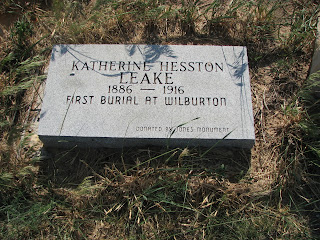 |
| A stone at the Wilburton, Kansas cemetery. The stone says the cemetery was established in 1916. |
 |
| Stones in the cemetery. |
 |
| The first burial was Katherine Hesston Leake, who died in 1916. She was 30. |
 |
| A few old outbuildings at Wilburton. |
 |
| An abandoned bus |
As several populated the area, a town was formed in 1912 halfway
between Elkhart
and Rolla. They named it Tice, the name of a high official of the Santa Fe
Railroad. They platted out lots on 20 acres along what would eventually be the Santa Fe track.
But when a post office was built in 1913 by Mrs. Nellie D.
Wilbur, the town became known as Wilburton, according to the history book.
At first, the train at Wilburton never stopped. The outgoing mail
was hung on a high post near the track. When the train passed, the incoming
mail was pushed out of the train and the out-going mail was grabbed from the
pole.
Eventually, when area residents began to ship cream, hides and
other products, the train would stop. The depot was an old boxcar that sat
besides the tracks, the name Wilburton on a board across the top.
It didn’t take long for the little town to bustle with residents
and commerce. Wilburton boasted two dry-good stores, two groceries, a church,
garage, grain elevators, a feed yard, bank, lumberyard and florist. There also
was a stockyard, boarding house, shoe repair shop and telephone exchange. The
grade school and high schools had more than 100 students.
“The population of the town for many years was in the hundreds,”
the book states.
When 2-year-old Rena Coen died of dust pneumonia, the closest
cemetery was covered in drifts of dirt.
So the Morton County farm family with seven sons buried their only
girl in the Rolla
Cemetery – just one of several
causalities of the Dirty Thirties.
Her brother, Dale, now 91, recalls those days well, remembering
how as a teen he would watch the billowing clouds of dust roll in, darkening
the sky and leaving dust covering almost every foot of the family farmstead – a
dust that was easily inhaled deep into the lungs.
It also blanketed the Wilburton cemetery.
“It was blowed under from the dust,” he said, adding the cemetery
wasn’t well-kept, either. “A bunch of us boys, four or five of us, dug it out,
got the markers dug out so the graves wouldn’t be lost.”
Wilburton, too, didn’t survive through the dust storms and the
Great Depression. Today, only a few homes dot the prairie landscape where a
thriving community was stood.





No comments:
Post a Comment